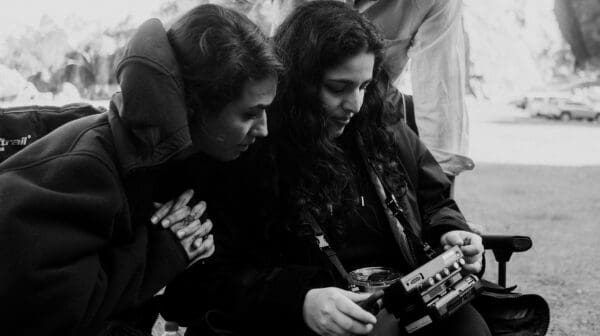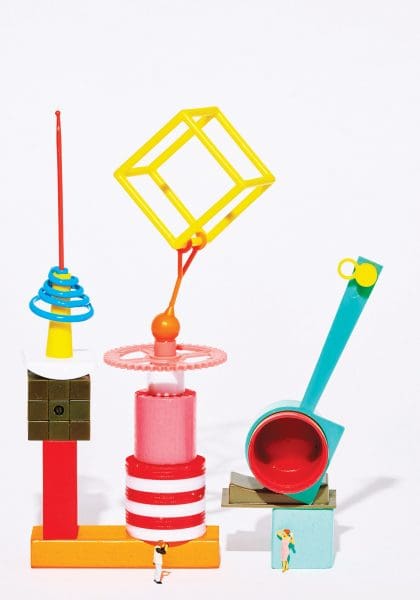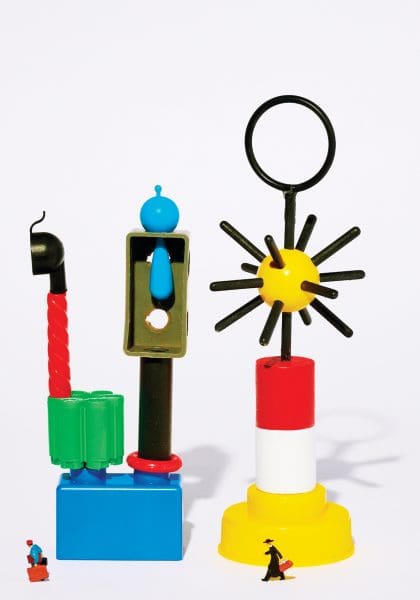
Finding New Spaces Together
‘Vádye Eshgh (The Valley of Love)’ is a collaboration between Second Generation Collective and Abdul-Rahman Abdullah weaving through themes of beauty, diversity and the rebuilding of identity.






A miniature porter walks ahead of a miniature priest. Overhead looms a vivid plastic construction, all colour and form, giving the tiny people their own tiny and architecturally delightful world. The porter and priest are a brilliant pair—it almost sounds like a bar joke—and there are other finely matched characters: the backpacker and the performance artist, the dandy and the daredevil, the bride and the groom. The sculptural backdrop changes for each pairing, and despite being new artworks these plastic assemblages are immediately recognisable: it’s Louise Paramor.
With a practice defined by collapsible paper sculptures and found plastics in bright colours, Paramor places seemingly-useless objects together in forms that feel wondrous and novel, albeit with an underlying complexity. Often referencing a persona, scene or architecture—the title is the clue—Paramor’s work lends itself to an easy humour that crosses both the naive and conceptual. But for Paramor, art-making comes from that highly inexpressible quality which so often gives rise to expression itself: “It’s intuition,” she says.
Although based in Melbourne for over three decades, Paramor grew up in Perth within a family that, as she puts it, “wasn’t particularly artistic”. Until encountering a good art teacher in high school, she didn’t really think studying art was a possibility. Originally starting with a painting practice (which she still maintains), Paramor soon became well-known for her assemblages of found plastic, which began in the mid-2000s. “I had a studio in Footscray in 2004 and I started to collect plastics from the $2 shops,” she recalls. “And as far as my attraction to the plastic, initially it was the fact that I really love colour, and playing around with colour, and combining it in a way that works and that doesn’t look garish.” That the materials were inexpensive and easily within arm’s reach was also a virtue, where “the strange forms that were designed came out of the production of domestic goods, throwaway goods.”
These ‘strange forms’ come in a variety of scales. There are public art pieces like her well-known Panorama Station, 2012, which resides on a Melbourne freeway and resembles something like a rocket launch-pad. Sitting at 17 metres tall, it’s based on an assemblage of objects like 1970s cassette towers, lampshades and spice jars. Then there are installations like the brilliantly-placed anthropomorphic sculptures at an outdoor tennis court at The Rod Laver Arena in 2007, and her much applauded 2017 survey show Palace of the Republic, shown at the National Gallery of Victoria’s The Ian Potter Centre: NGV Australia.

Paramor often creates in response to the size of her exhibiting environment. For an upcoming show at Melbourne’s Finkelstein Gallery, titled Parallel Universe, she’s opted for 13 small-scale assemblages in glass cases, accompanied by 13 photographic prints of the assemblages. Her use of the tiny human forms alongside the assemblages is what first draws the eye, and is a new development for her practice. “I came across these quite detailed architectural [human] figures that were beautiful in themselves,” she explains. “I made a series of small assemblage works and matched the people to the assemblage. I’m always using human forms against my maquettes to present an idea.” In bringing human figures into the sculptural space, and placing them next to the assemblages, Paramor not only sets up a variety of scenes and architectural moods, but gives a larger-than-life quality to the new worlds she’s creating.
To produce these assemblages, there are certain requirements. “I need an awful lot of raw material,” explains Paramor. “To make that series [in Parallel Universe] I probably had one 100-fold the amount of stuff to play with.” When creating a new series, the artist often focuses on a particular scale, and has collections of different scales of material to draw from. “But it can only occur within a framework of time,” she adds. “I can only focus on one thing for a couple of months, or a few months, and then it’s over and I put everything away.”
While Paramor has a fairly systematised process, and is in the studio almost every day, she also works part-time at a bar and, like many artists, works with questions of exhaustion and perfection. “I’ll play around and come to a conclusion,” she says of creating her assemblages, “and then at a certain point I’ve exhausted it for myself. I either can’t look anymore at them, or I just feel that the series is completed.”
But what does it take for a scene like a porter and a priest, along with their assembled world, to come into existence? “It’s just my intuition,” she explains. “I think it’s just what pleases me.” While Paramor is invested in the aesthetics of her assemblages, she’s not loudly referencing or commenting upon many of the obvious art-historical styles her work can be seen to invoke: modernism, abstraction, the readymade and pop art.
Yet there is an undeniable social aspect to these works. As Jason Smith, director of Geelong Art Gallery, once said in Art Collector magazine, Paramor’s assemblages “comment powerfully on some of the pressing issues of our time: uncontrollable consumption, easy obsolescence, environmental degradation, and desensitisation to the beauty in some ordinary things.” Finding this true, I ask Paramor what she thinks. “Some of it, but I have to admit it’s more unconsciously.” She pauses. “I guess we all see beauty in different things, don’t we?” Towards the end of our conversation, she reaches for something more final: “I think it’s so hard to commit to making art that however you do it, whatever your rationale is, if you have a need to do it, then you do it.”
Parallel Universe
Louise Paramor
Finkelstein Gallery
4 February—13 March
This article was originally published in the January/February 2021 print issue of Art Guide Australia.